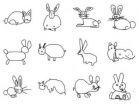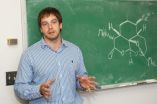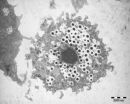(Press-News.org)
VIDEO:
To develop a program that allows computers to recognize rough sketches, we need to understand how humans actually sketch objects. Researchers from Brown University and the Technical University of Berlin...
Click here for more information.
PROVIDENCE, R.I. [Brown University] — First they took over chess. Then Jeopardy. Soon, computers could make the ideal partner in a game of Draw Something (or its forebear, Pictionary).
Researchers from Brown University and the Technical University of Berlin have developed a computer program that can recognize sketches as they're drawn in real time. It's the first computer application that enables "semantic understanding" of abstract sketches, the researchers say. The advance could clear the way for vastly improved sketch-based interface and search applications.
The research behind the program was presented last month at SIGGRAPH, the world's premier computer graphics conference. The paper is now available online (http://cybertron.cg.tu-berlin.de/eitz/projects/classifysketch/), together with a video, a library of sample sketches, and other materials.
Computers are already pretty good at matching sketches to objects as long as the sketches are accurate representations. For example, applications have been developed that can match police sketches to actual faces in mug shots. But iconic or abstract sketches — the kind that most people are able to easily produce — are another matter entirely.
For example, if you were asked to sketch a rabbit, you might draw a cartoony-looking thing with big ears, buckteeth, and a cotton tail. Another person probably wouldn't have much trouble recognizing your funny bunny as a rabbit — despite the fact that it doesn't look all that much like a real rabbit.
"It might be that we only recognize it as a rabbit because we all grew up that way," said James Hays, assistant professor of computer science at Brown, who developed the new program with Matthias Eitz and Marc Alexa from the Technical University in Berlin. "Whoever got the ball rolling on caricaturing rabbits like that, that's just how we all draw them now."
Getting a computer to understand what we've come to understand through years of cartoons and coloring books is a monumentally difficult task. The key to making this new program work, Hays says, is a large database of sketches that could be used to teach a computer how humans sketch objects. "This is really the first time anybody has examined a large database of actual sketches," Hays said.
To put the database together, the researchers first came up with a list of everyday objects that people might be inclined to sketch. "We looked at an existing computer vision dataset called LabelMe, which has a lot of annotated photographs," Hays said. "We looked at the label frequency and we got the most popular objects in photographs. Then we added other things of interest that we thought might occur in sketches, like rainbows for example."
They ended up with a set of 250 object categories. Then the researchers used Mechanical Turk, a crowdsourcing marketplace run by Amazon, to hire people to sketch objects from each category — 20,000 sketches in all. Those data were then fed into existing recognition and machine learning algorithms to teach the program which sketches belong to which categories. From there, the team developed an interface where users input new sketches, and the computer tries to identify them in real time, as quickly as the user draws them.
As it is now, the program successfully identifies sketches with around 56-percent accuracy, as long as the object is included in one of the 250 categories. That's not bad, considering that when the researchers asked actual humans to identify sketches in the database, they managed about 73-percent accuracy. "The gap between human and computational performance is not so big, not as big certainly as it is in other computer vision problems," Hays said.
The program isn't ready to rule Pictionary just yet, mainly because of its limited 250-category vocabulary. But expanding it to include more categories is a possibility, Hays says. One way to do that might be to turn the program into a game and collect the data that players input. The team has already made a free iPhone/iPad app that could be gamified.
"The game could ask you to sketch something and if another person is able to successfully recognize it, then we can say that must have been a decent enough sketch," he said. "You could collect all sorts of training data that way."
And that kind of crowdsourced data has been key to the project so far.
"It was the data gathering that had been holding this back, not the digital representation or the machine learning; those have been around for a decade," Hays said. "There's just no way to learn to recognize say, sketches of lions, based on just a clever algorithm. The algorithm really needs to see close to 100 instances of how people draw lions, and then it becomes possible to tell lions from potted plants."
Ultimately a program like this one could end up being much more than just fun and games. It could be used to develop better sketch-based interface and search applications. Despite the ubiquity of touch screens, sketch-based search still isn't widely used, but that's probably because it simply hasn't worked very well, Hays says.
A better sketch-based interface might improve computer accessibility. "Directly searching for some visual shape is probably easier in some domains," Hays said. "It avoids all language issues; that's certainly one thing."
INFORMATION:
Computer program can identify rough sketches
Could clear the way for better sketch-based interface and search
2012-09-13
ELSE PRESS RELEASES FROM THIS DATE:
Effects of stopping alcohol consumption on subsequent risk of esophageal cancer
2012-09-13
Cancer of the oesophagus is becoming more common in Europe and North America. Around 7,800 people in the UK are diagnosed each year. The exact causes of this cancer aren't fully understood. It appears to be more common in people who have long-term acid reflux (backflow of stomach acid into the oesophagus). Other factors that can affect the risk of developing cancer of the oesophagus include:
Gender – It is more common in men than in women.
Age – The risk of developing oesophageal cancer increases as we get older. It occurs most commonly in people over 45.
Smoking ...
U-M guidelines help family physicians evaluate, manage urinary incontinence for women
2012-09-13
ANN ARBOR, Mich. — Millions of women experience a loss of bladder control, or urinary incontinence, in their lifetime.
It's a common and often embarrassing problem that many patients don't bring up with their doctors – and when they do, it may be mentioned as a casual side note during a visit for more pressing medical issues.
Now, new guidelines from doctors at the University of Michigan Health System offer family physicians a step-by-step guide for the evaluation of urinary leakage, to prevent this quality-of-life issue from being ignored.
"I think a lot of physicians ...
Parental divorce linked to stroke in males
2012-09-13
TORONTO, ON – Men with divorced parents are significantly more likely to suffer a stroke than men from intact families, shows a new study from the University of Toronto.
The study, to be published this month in the International Journal of Stroke, shows that adult men who had experienced parental divorce before they turned 18 are three times more likely to suffer a stroke than men whose parents did not divorce. Women from divorced families did not have a higher risk of stroke than women from intact families.
"The strong association we found for males between parental ...
Lack of oxygen in cancer cells leads to growth and metastasis
2012-09-13
It seems as if a tumor deprived of oxygen would shrink. However, numerous studies have shown that tumor hypoxia, in which portions of the tumor have significantly low oxygen concentrations, is in fact linked with more aggressive tumor behavior and poorer prognosis. It's as if rather than succumbing to gently hypoxic conditions, the lack of oxygen commonly created as a tumor outgrows its blood supply signals a tumor to grow and metastasize in search of new oxygen sources – for example, hypoxic bladder cancers are likely to metastasize to the lungs, which is frequently deadly. ...
Laser-powered 'needle' promises pain-free injections
2012-09-13
VIDEO:
The movie shows the injector firing into open air without a skin or gel target. The jet, which is approximately the diameter of a human hair, seems dispersed but a...
Click here for more information.
WASHINGTON, Sept. 13—From annual flu shots to childhood immunizations, needle injections are among the least popular staples of medical care. Though various techniques have been developed in hopes of taking the "ouch" out of injections, hypodermic needles are still the ...
IU chemist develops new synthesis of most useful, yet expensive, antimalarial drug
2012-09-13
BLOOMINGTON, Ind. -- In 2010 malaria caused an estimated 665,000 deaths, mostly among African children. Now, chemists at Indiana University have developed a new synthesis for the world's most useful antimalarial drug, artemisinin, giving hope that fully synthetic artemisinin might help reduce the cost of the live-saving drug in the future.
Effective deployment of ACT, or artemisinin-based combination therapy, has been slow due to high production costs of artemisinin. The World Health Organization has set a target "per gram" cost for artemisinin of 25 cents or less, but ...
Study of giant viruses shakes up tree of life
2012-09-13
CHAMPAIGN, Ill. — A new study of giant viruses supports the idea that viruses are ancient living organisms and not inanimate molecular remnants run amok, as some scientists have argued. The study reshapes the universal family tree, adding a fourth major branch to the three that most scientists agree represent the fundamental domains of life.
The new findings appear in the journal BMC Evolutionary Biology.
The researchers used a relatively new method to peer into the distant past. Rather than comparing genetic sequences, which are unstable and change rapidly over time, ...
Scientists use sound waves to levitate liquids, improve pharmaceuticals
2012-09-13
It's not a magic trick and it's not sleight of hand – scientists really are using levitation to improve the drug development process, eventually yielding more effective pharmaceuticals with fewer side effects.
Scientists at the U.S. Department of Energy's (DOE) Argonne National Laboratory have discovered a way to use sound waves to levitate individual droplets of solutions containing different pharmaceuticals. While the connection between levitation and drug development may not be immediately apparent, a special relationship emerges at the molecular level.
At the molecular ...
Increased dietary fructose linked to elevated uric acid levels and lower liver energy stores
2012-09-13
Obese patients with type 2 diabetes who consume higher amounts of fructose display reduced levels of liver adenosine triphosphate (ATP)—a compound involved in the energy transfer between cells. The findings, published in the September issue of Hepatology, a journal of the American Association for the Study of Liver Diseases, indicate that elevated uric acid levels (hyperuricemia) are associated with more severe hepatic ATP depletion in response to fructose intake.
This exploratory study, funded in part by grants from the National Institute of Diabetes and Digestive and ...
Poorest miss out on benefits, experience more material hardship, since 1996 welfare reform
2012-09-13
Although the federal government's 1996 reform of welfare brought some improvements for the nation's poor, it also may have made extremely poor Americans worse off, new research shows.
The reforms radically changed cash assistance—what most Americans think of as 'welfare'— by imposing lifetime limits on the receipt of aid and requiring recipients to work. About the same time, major social policy reforms during the 1990s raised the benefits of work for low-income families.
In the wake of these changes, millions of previous welfare recipients, largely single mothers, ...
LAST 30 PRESS RELEASES:
Study showcases resilience and rapid growth of “living rocks”
Naval Research Lab diver earns Office of Naval Research 2025 Sailor of the Year
New Mayo-led study establishes practical definition for rapidly progressive dementia
Fossil fuel industry’s “climate false solutions” reinforce its power and aggravate environmental injustice
Researchers reveal bias in a widely used measure of algorithm performance
Alcohol causes cancer. A study from IOCB Prague confirms damage to DNA and shows how cells defend against it
Hidden viruses in wastewater treatment may shape public health risks, study finds
Unlock the power of nature: how biomass can transform climate mitigation
Biochar reshapes hidden soil microbes that capture carbon dioxide in farmland
Reducing saturated fat intake shows mortality benefit, but only in high-risk individuals
Manta rays create mobile ecosystems, study finds
Study: Mixed results in using lipoic acid to treat progressive multiple sclerosis
Norbert Holtkamp appointed director of Fermi National Accelerator Laboratory
New agentic AI platform accelerates advanced optics design
Biologists discover neurons use physical signals — not electricity — to stabilize communication
Researchers discover that a hormone can access the brain by hitchhiking
University of Oklahoma researcher awarded funding to pursue AI-powered material design
Exploring how the visual system recovers following injury
Support for parents with infants at pediatric check-ups leads to better reading and math skills in elementary school
Kids’ behavioral health is a growing share of family health costs
Day & night: Cancer disrupts the brain’s natural rhythm
COVID-19 vaccination significantly reduces risk to pregnant women and baby
The role of vaccination in maternal and perinatal outcomes associated with COVID-19 in pregnancy
Mayo Clinic smartwatch system helps parents shorten and defuse children's severe tantrums early
Behavioral health spending spikes to 40% of all children’s health expenditures, nearly doubling in a decade
Digital cognitive behavioral treatment for generalized anxiety disorder
Expenditures for pediatric behavioral health care over time and estimated family financial burden
Air conditioning in nursing homes and mortality during extreme heat
The Alps to lose a record number of glaciers in the next decade
What makes a good proton conductor?
[Press-News.org] Computer program can identify rough sketchesCould clear the way for better sketch-based interface and search



